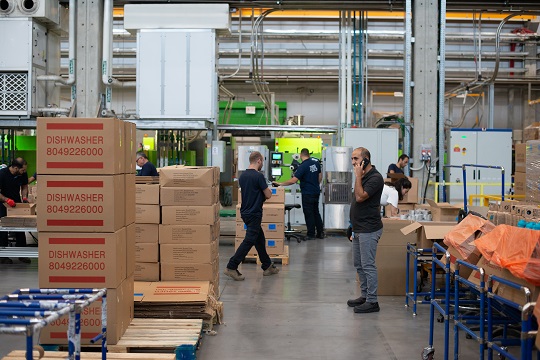In your modern world of logistics and warehousing, you know that efficiency and accuracy are crucial factors for successful operations. That’s why two popular methods, Pick to Light and Voice Picking, have revolutionized order picking processes.
Both methods offer unique advantages and have specific suitability based on different operational conditions.
In this blog post, we will delve into the characteristics, strengths, and weaknesses of each method and discuss the necessary preparations for implementing them.
But before we delve deeper, make sure you have joined the scmguide telegram channel to receive notifications of the latest posts from this blog as well as more insights on supply chain management.
Table of Contents
Pick to Light
When it comes to Pick to Light, you will discover that it is an order picking technology that empowers you to utilize light indicators to guide yourself and your fellow workers to specific items within your warehouse.
Each item location is equipped with a light module that illuminates precisely when an item needs to be picked.
Let’s explore the key considerations for implementing Pick to Light.
Suitable Conditions
If you have high-density SKU (Stock Keeping Unit) storage systems, Pick to Light can be a suitable choice for you. It efficiently organizes and streamlines the picking process in such environments.
Pick to Light works exceptionally well for small and lightweight items. The system’s accuracy and speed complement the nature of these items, enhancing your overall productivity.

If you deal with fast-moving products or high order volume, implementing Pick to Light can significantly improve your order picking efficiency. The visual guidance provided by the light modules minimizes search and travel time, enabling you to handle more orders in less time.
Additionally, if you have limited space and a need for compact picking zones, Pick to Light can optimize your available space by efficiently organizing the picking areas.
Advantages of Pick to Light
Increased Efficiency
With the visual guidance provided by the light modules, you can minimize search and travel time during the picking process. This leads to faster order fulfillment and improved overall efficiency.
Error Reduction
The Pick to Light system significantly reduces the likelihood of picking errors. By being directed to the exact location and quantity of items, you can ensure greater accuracy in fulfilling orders, thereby enhancing customer satisfaction.
Scalability
One of the notable advantages of Pick to Light is its scalability. As your warehouse layout or product range changes, this method can easily accommodate those changes, allowing for a seamless integration of new SKUs and modifications to your order picking processes.
You might also like:
- The Dilemma of Using Plastic Wrap for Temporary Storage: Cost vs. Sustainability
- Is It Time to Upgrade? Assessing the Benefits of Replacing an Aging Forklift
Limitations of Pick to Light
Initial Investment
It’s important to be aware that implementing a Pick to Light system requires a significant upfront investment in terms of hardware and software. You must carefully evaluate the potential return on investment (ROI) to ensure it aligns with your business goals.
Limited Item Flexibility
While Pick to Light is ideal for small, similar-sized items, it may not be the most suitable method for larger or irregularly shaped products. You should consider the nature of your inventory and determine if Pick to Light can effectively handle its diversity.
Space Requirements
Implementing Pick to Light may require additional space within your warehouse. The installation of light modules and wiring might necessitate modifications to your warehouse layout. Therefore, you should assess the availability of space and consider the potential impact on your existing operations.
Voice Picking
When it comes to Voice Picking, you will find that it is an order picking method that empowers you and your fellow workers to receive instructions through a headset and verbally confirm your actions.
Let’s explore the key considerations for implementing Voice Picking.
Suitable Conditions
If you deal with variable product sizes and shapes, Voice Picking can be an ideal choice for you. Its flexibility allows you to efficiently handle diverse inventory, regardless of the product dimensions or configurations.

Voice Picking is particularly well-suited for warehouses with diverse order profiles that involve medium to high order volumes. Its adaptability ensures that you can handle varying order requirements effectively.
In work environments characterized by noise or limited visibility, Voice Picking shines. By relying on auditory instructions, it minimizes the impact of environmental factors on your order picking accuracy and productivity.
Advantages of Voice Picking
Hands-Free Operation
With Voice Picking, you can enjoy a hands-free operation. By receiving instructions through a headset, you have both hands available for picking tasks. This not only increases your productivity but also reduces fatigue, leading to a more comfortable and efficient work experience.
Flexibility
Voice Picking is highly flexible and adaptable to a wide range of product sizes and shapes. Whether you’re dealing with small, large, irregular, or specialized items, this method can effectively guide you in picking the right items with accuracy and precision.
Training and Onboarding
Voice Picking is relatively easy to learn and implement, which makes training and onboarding of new employees faster and more efficient. Its simplicity allows workers to quickly grasp the voice commands and integration with existing warehouse processes.
You might also like:
- From Storage to Success: The Art of Leveraging Warehousing for Strategic Gain
- Pallets in the Factory: Dedicated or General-Purpose?
Limitations of Voice Picking
Accuracy Relies on Communication
It’s important to note that the accuracy of Voice Picking relies heavily on effective communication. Misinterpretations of instructions or background noise may occasionally lead to errors if the instructions are not clearly understood.
It is crucial to establish clear communication protocols and ensure a conducive working environment to minimize such issues.
Dependency on Infrastructure
Voice Picking requires a reliable network connection and seamless integration with warehouse management systems.
Ensuring a robust infrastructure, including network connectivity and proper software integration, is essential for smooth implementation and optimal performance.
Upfront Costs
While generally more affordable than Pick to Light, Voice Picking still incurs costs for headsets and software. You should consider the initial investment required and conduct a cost-benefit analysis to ensure that the potential benefits outweigh the expenses.
Preparations for Implementation
Regardless of which method you choose, there are certain preparations that are essential for a successful implementation.
Let’s explore these preparations.
Thorough Analysis
It’s crucial for you to conduct a comprehensive analysis of your warehouse operations. Consider factors such as order volume, product variety, and space constraints.
This analysis will help you determine which method, Pick to Light or Voice Picking, is best suited for your specific operational needs.
Process Optimization
Before implementing any new technology, it’s important to streamline and optimize your order picking processes. Look for areas where improvements can be made to maximize efficiency gains.
By optimizing your existing processes, you can ensure a smooth transition to the chosen method and enhance overall productivity.
Training and Change Management
Implementing a new order picking method involves change, and change can sometimes be met with resistance. To minimize resistance and ensure a successful implementation, provide sufficient training to your employees.
Familiarize them with the chosen method and its procedures, and highlight the benefits it will bring. Effective change management strategies will facilitate a smooth transition and improve employee adoption of the new system.
Infrastructure Evaluation
Evaluate your existing infrastructure to ensure it is ready to support the chosen method. Consider aspects such as network connectivity and compatibility with the hardware and software requirements of the method.
This evaluation will help you identify any necessary upgrades or modifications needed to ensure a seamless integration of the new system.
Return on Investment (ROI) Analysis
Before implementing Pick to Light or Voice Picking, it’s important to conduct a thorough cost-benefit analysis.
Assess the potential return on investment of each method by considering factors such as initial investment costs, expected efficiency gains, and long-term benefits.
This analysis will help you make an informed decision based on the financial viability and overall impact on your warehouse operations.
Conclusion
In conclusion, both Pick to Light and Voice Picking offer unique advantages and are suited for different operational conditions. As you consider implementing these methods in your warehouse, it’s important for you to assess their suitability based on your specific requirements.
Pick to Light is particularly effective in high-density SKU environments with small, lightweight items, while Voice Picking provides flexibility for diverse inventory and enables hands-free operation.
By conducting a thorough analysis of your warehouse, optimizing processes, providing adequate training to your employees, evaluating your infrastructure, and assessing the potential return on investment, you can make an informed decision.
Implementing the most suitable method will not only enhance the efficiency and accuracy of your order picking operations but also contribute to overall improvements in your warehouse productivity.
Hope it is useful!
Please also share this article with your colleagues so that they can benefit from it as well. Join our scmguide telegram channel to receive notifications of the latest posts from this blog and gain more insights into supply chain management. All articles on this blog are free for you to use for any purpose, including commercial, without the need for attribution.

 by
by 

